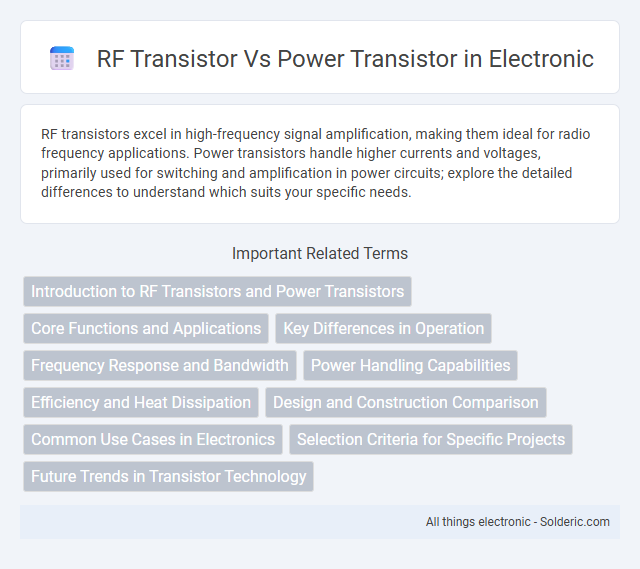RF transistors excel in high-frequency signal amplification, making them ideal for radio frequency applications. Power transistors handle higher currents and voltages, primarily used for switching and amplification in power circuits; explore the detailed differences to understand which suits your specific needs.
Comparison Table
| Feature | RF Transistor | Power Transistor |
|---|---|---|
| Primary Use | High-frequency signal amplification (RF circuits) | High current and voltage switching or amplification |
| Frequency Range | Up to several GHz | Low to medium frequencies (kHz to MHz) |
| Power Handling | Low to moderate power (mW to a few watts) | High power (watts to kilowatts) |
| Gain | High gain at high frequencies | Moderate gain, optimized for power |
| Packages | Small signal packages, surface mount | Large heat sink packages for thermal management |
| Applications | RF amplifiers, oscillators, wireless devices | Power amplifiers, motor drives, power supplies |
| Thermal Management | Moderate heat dissipation requirements | High heat dissipation, often with heat sinks or cooling |
Introduction to RF Transistors and Power Transistors
RF transistors are specialized semiconductor devices designed to operate efficiently at high frequencies, typically ranging from hundreds of MHz to several GHz, making them essential for radio frequency amplification and signal processing in wireless communication systems. Power transistors, on the other hand, are optimized to handle high voltage and current levels to switch or amplify electrical power in applications such as power supplies, motor drives, and audio amplifiers. Understanding the distinction between RF and power transistors helps you select the right component based on frequency performance requirements and power handling capabilities.
Core Functions and Applications
RF transistors are designed to amplify high-frequency signals in communication devices such as radios, cell phones, and satellite transmitters, where signal integrity at gigahertz frequencies is critical. Power transistors handle high current and voltage levels to drive loads in applications like power amplifiers, motor controls, and power supplies, emphasizing thermal management and efficiency. While RF transistors prioritize low noise and high gain at radio frequencies, power transistors focus on robust performance under high power conditions.
Key Differences in Operation
RF transistors operate primarily at high frequencies, designed to amplify weak radio signals with minimal noise, while power transistors handle higher currents and voltages to drive loads like motors or amplifiers. The key difference lies in their construction and material properties, with RF transistors optimized for fast switching and low capacitance, and power transistors built to manage thermal dissipation and high power output efficiently. Understanding these operational distinctions helps you select the appropriate transistor type for your electronic circuit's specific frequency and power requirements.
Frequency Response and Bandwidth
RF transistors exhibit superior frequency response and wider bandwidth compared to power transistors, making them ideal for high-frequency applications such as radio frequency amplification and RF signal processing. Power transistors prioritize high current and voltage handling capabilities but typically have limited frequency response and narrower bandwidth, restricting their effectiveness in high-frequency circuits. The inherent design differences, including lower parasitic capacitances and optimized transistor geometries in RF transistors, enable operation well into the GHz range, unlike power transistors which generally operate efficiently at lower frequencies.
Power Handling Capabilities
RF transistors are optimized for high-frequency signal amplification but typically handle lower power levels compared to power transistors, which are specifically designed to manage higher current and voltage loads. Power transistors excel in applications requiring robust power handling capabilities, such as in power supplies, motor drives, and audio amplifiers. When selecting components for your electronic design, understanding the distinct power handling strengths ensures optimal performance and reliability.
Efficiency and Heat Dissipation
RF transistors are designed for high-frequency signal amplification with optimized efficiency at GHz ranges, resulting in lower heat dissipation during radio frequency operations. Power transistors handle higher current loads and voltages, often generating more heat due to greater power dissipation, requiring effective thermal management. Your choice between RF and power transistors depends on balancing efficiency needs and heat dissipation based on the specific frequency and power applications.
Design and Construction Comparison
RF transistors feature specialized semiconductor materials like GaAs or SiGe and incorporate optimized internal geometries to achieve high-frequency performance with minimal parasitic capacitances and inductances. Power transistors typically use silicon with robust, thick drift regions designed to handle high voltage and current levels, emphasizing heat dissipation and power robustness over frequency response. The construction of RF transistors includes intricate gate structures and small transistor geometries for fast switching, whereas power transistors prioritize larger die sizes and enhanced packaging for thermal management.
Common Use Cases in Electronics
RF transistors are primarily used in high-frequency applications such as radio frequency amplifiers, oscillators, and communication transmitters due to their ability to operate efficiently at microwave frequencies. Power transistors are designed for handling high voltage and current levels in applications like power supply regulation, motor control, and audio amplification, where robustness and thermal performance are critical. RF transistors emphasize gain and linearity at GHz frequencies, while power transistors focus on durability and energy dissipation in high-power circuits.
Selection Criteria for Specific Projects
RF transistor selection focuses on high-frequency performance, low noise, and gain stability, essential for communication and signal amplification projects. Power transistors prioritize high current handling, voltage tolerance, and thermal management to efficiently drive and control large loads in power supply or motor control applications. Your project requirements for frequency range, power output, and thermal constraints will guide the optimal choice between RF and power transistors.
Future Trends in Transistor Technology
RF transistors and power transistors are evolving rapidly to meet the demands of high-frequency communication and efficient energy management in future technologies. Advances in wide bandgap materials like GaN and SiC significantly enhance their performance, offering higher switching speeds, greater thermal stability, and increased power density. Your choice between RF and power transistors will hinge on these emerging capabilities, shaping next-generation applications in 5G networks, electric vehicles, and renewable energy systems.
RF transistor vs Power transistor Infographic

 solderic.com
solderic.com